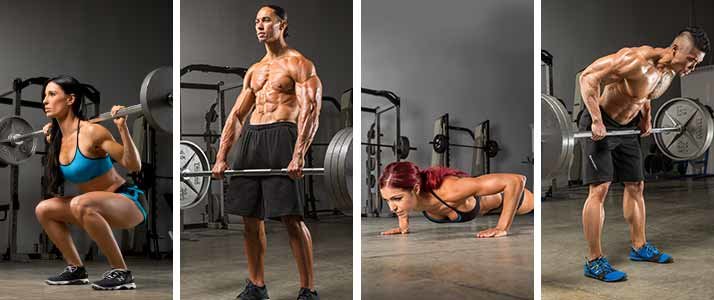
4 Easy Ways to Improve Classic Lifts
Building a better squat, deadlift, push-up, and row is as simple as changing the type of weight you use. Develop superior form with these four variations!
We live in an age where excess is the norm. Many people equate happiness and success with how many Apple products they own, what kind of cars they drive, or the number of vintage Thunder Cats T-shirts they have in their closet. Unfortunately, only the last of the three actually translates into real happiness.
Excess is also the norm in strength training. Many people head to the gym with the idea that they need more and more diverse exercises in their "exercise toolbox." The more variety they adopt, the thinking goes, the better the results they'll get.
I disagree. I believe simplicity is the key to success in training. And often, what you consider "variety" is just an excuse to skip something far more simple and effective.
Say you're not confident in your ability to perform free-weight classics like squats, deadlifts, push-ups, and rows. Or just as commonly, you are confident, but everyone watching you is only confident that you're going to end up in a PT's office.
Is the answer to skip these classic movements and do a bunch of other stuff instead? Or maybe you should just hop on the nearest 3-4 machines that collectively approximate the movement? No and no.

The answer is to do the moves, but do versions that teach you to squat, push, pull, and row with better form. In one sense, each of these four moves can be considered "regressions," in that there are no heavy barbells involved. But on the other hand, when you start performing movements properly and quit your cheating ways, they instantly become more difficult with lighter weights.
Funny how that works! Now let's get better at stuff.
Double Kettlebell Front Squat
I love back squats and use them frequently with my own training and that of my athletes and clients. However, I also love the double-kettlebell front squat as an alternative to the back squat, particularly for people who have back, shoulder, or hip-mobility issues that get in the way of their back squat, or even their front squat.
What's so different about the double kettlebell squat? The load is in front of you—even further out than a barbell front squat—and not directly over the spine, which makes it a more back-friendly squat variation. Because there's no shoulder external rotation required, it's more shoulder-friendly too.
TonyGentilcore.com Double Anterior Loaded KB Front Squat
Watch the video - 0:19
But friendliness aside, squatting with a pair of kettlebells usually leads to a better-looking squat than a barbell. The anterior load is excellent at teaching/forcing people to stay more upright and maintain more thoracic extension, or less upper-back rounding. Also, because of the anterior load (again), you'll have no choice but to posteriorly tilt the pelvis—i.e., no "butt wink"—and better align the lower half of the body. It's not uncommon to instantly see a vast improvement in squatting depth with this variation.
So it's easier, right? Not necessarily. Having a pood or two that far in front of you poses an unparalleled challenge to the core musculature. You have to fight hard not to tip over, and with a couple of even mildly heavy bells, breathing isn't all that easy, either. Definitely don't expect your best barbell back or front squat numbers to carry over to this move.
Band-Assisted/Resisted Push-Ups
Push-ups often get an eye-roll for being an "easy" exercise. Funny thing is, I rarely work with an individual—professional athletes included—who can perform a push-up well on the first day.
What's the solution? Have everyone perform so-called girl push-ups from the knees? No thanks. One reason is that I just hate the term "girl push-up." I think it reinforces the stupid idea that women are weak, delicate butterflies who need special exercises. As I explained in the article "4 Strength Goals for a Beautiful Body," women should be doing straight-up push-ups, for the simple reason that push-ups are great! [https://www.bodybuilding.com/fun/4-strength-goals-for-a-beautiful-body.html]
So when push-ups are a problem, rather than regressing to what is effectively a different movement, I use a band to help regress the exercise.
TonyGentilcore.com Band Assisted Push-Up
Watch the video - 0:16
When placed across the hips, the band allows the individual to maintain better lumbo-pelvic-hip control than in knee push-ups, but also allows them the opportunity to "groove" proper technique. It provides more assistance within the ROM where they'll need it most—at the bottom—and less help at the top. It's a regression, but it can easily be progressed by either moving the band closer to the floor or using a thinner band.
Then, when you can knock out clean push-ups by the dozens and are ready to progress, the same band can help you. Just loop it over your back and prepare to struggle.
TonyGentilcore.com Band Resisted Push-Up
Watch the video - 0:05
Kettlebell Hover Deadlift
Two common mistakes with the deadlift I notice are the upper back rounding, and the hips coming up too fast. While the culprit could be that the weight is too heavy, that's not the only explanation. I find that when either of the two occur, more often than not it's lack of tension, specifically in the lats, that's responsible.
Sure, you can do paused deadlifts to help with this, but as with front squats, I think the kettlebell has a lot going for it here. The kettlebell hover deadlift is a simple and very approachable way to help teach someone how to build and apply tension in their lats/upper back.
TonyGentilcore.com Hover Deadlift
Watch the video - 1:59
To do it, just stand directly above two kettlebells (you can also use one), push your hips back, knees out, and try to melt the handles with your hands. Then, instead of standing straight up with the weight, "hover" an inch or two above the ground for 1-5 seconds. This will ensure you maintain tension in the upper back and prevent any rounding, as well as prevent the bell from drifting away from your body.
Lock out at the top and return back to the ground, hovering again 1-2 inches above the floor for a 1- to 5-second count before coming to a complete stop. While the movement is more visually similar to a sumo deadlift than a conventional deadlift, it carries over very well to both barbell variations in my experience.
Meadows Row
This move is named after professional bodybuilder John Meadows. For many people, it isn't so much a regression as it is a variation for those who have "outgrown" their gym's dumbbell rack and need to up the ante with their rows.
However, I use this exercise with a lot of my beginner/intermediate clients, as I feel it provides more of a full-body training effect and helps encourage a better rowing form.
TonyGentilcore.com One-Arm Meadows Row
Watch the video - 0:13
You can build up to going as heavy as you want here, but a word to the wise: I'd opt to use 10- to 25-pound plates only, as anything larger tends to be more cumbersome and gets in the way. I also prefer to perform these with a staggered stance, where the leg closest to the weight is back.
Otherwise, the cues are similar to a dumbbell row. Try to focus on pulling through the elbow rather than twisting your back, and like the push-up, try not to pin your shoulder blade in place. Feel a nice stretch in the bottom, and then think about pulling your elbow toward your hip.
Spend some time with any of these variations, and I can guarantee that you'll get stronger at the movements themselves, no matter what amount of added weight you use. Then, you can either go back to the "classic" version to see how much it carries over, or just keep riding one of these to see how far you can go with them!

